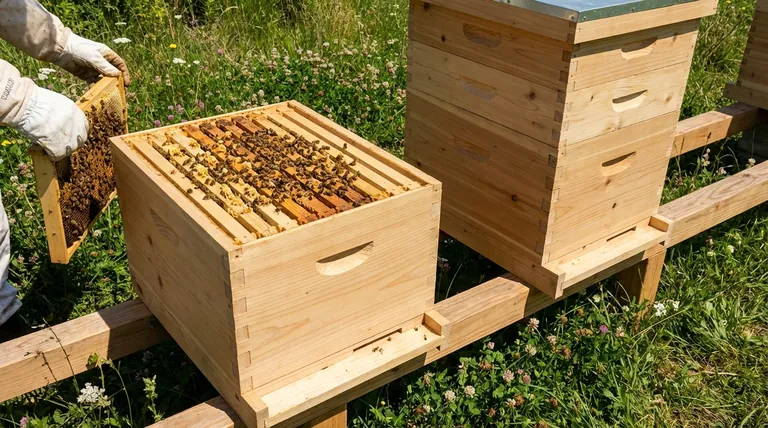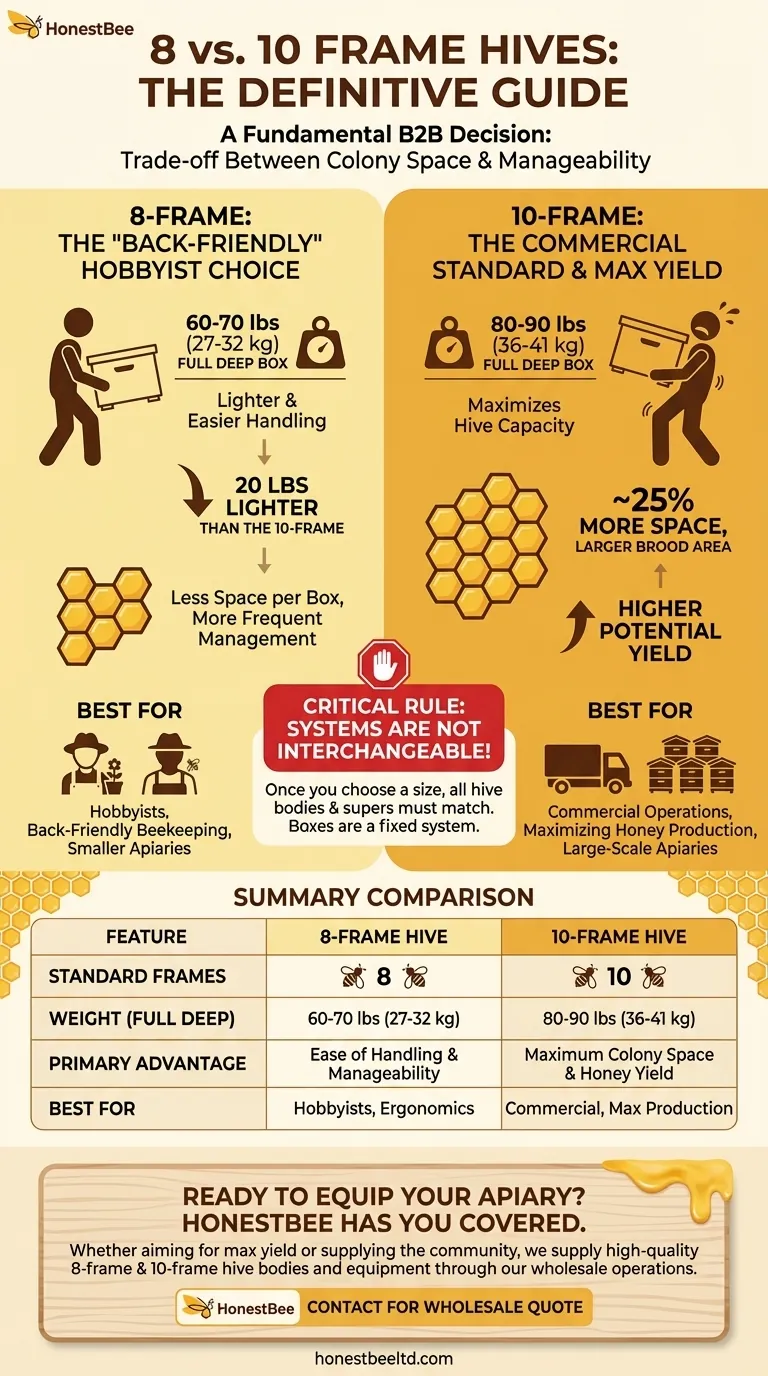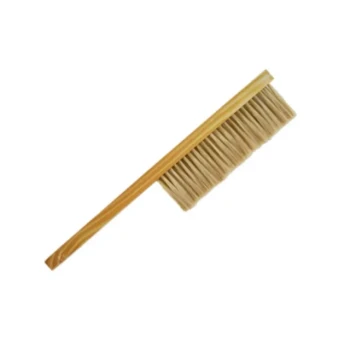To be direct, a standard Langstroth hive body or super holds either 8 or 10 frames. The choice between these two sizes is one of the most fundamental decisions a beekeeper makes, as all subsequent boxes for that hive must match. The 10-frame hive is the traditional standard, while the 8-frame hive is a popular modern alternative.
The decision between an 8-frame and a 10-frame hive is not about which is "better," but about a direct trade-off: The 10-frame offers maximum space for the colony, while the 8-frame offers significantly easier physical management for the beekeeper.

The Two Standards: 8-Frame vs. 10-Frame Hives
While the length of a frame is standardized, the width of the hive box is not. This variation creates two distinct systems that are not interchangeable. Understanding the original intent and the modern alternative is key to choosing the right path.
The 10-Frame Standard: Maximizing Space
The 10-frame hive is the long-standing industry standard. It was designed to provide ample room for a large, productive honey bee colony.
This configuration offers about 25% more space per box than an 8-frame hive. This means more cells for the queen to lay eggs (brood) and more space for workers to store honey and pollen.
For commercial operations or beekeepers aiming to maximize honey yield per hive, the 10-frame system is often the default choice due to its larger capacity.
The 8-Frame Alternative: Prioritizing Manageability
The 8-frame hive is a direct response to the primary drawback of the 10-frame system: its weight. By reducing the width of the box to hold two fewer frames, the entire system becomes lighter and easier to handle.
This is often called the "back-friendly" or "hobbyist" hive. While it holds less honey per box, the reduced physical strain is a significant advantage for many beekeepers.
Because each box has less volume, a beekeeper might need to add supers more frequently or use more boxes overall to achieve the same storage capacity as a 10-frame hive.
Understanding the Core Trade-offs
Your choice will impact your entire beekeeping experience, from routine inspections to honey harvesting. The decision hinges almost entirely on one factor: weight.
Hive Weight and Physical Strain
This is the most critical difference. A deep 10-frame hive body filled with brood, pollen, and honey can weigh 80 to 90 pounds (36-41 kg).
In contrast, a full 8-frame deep hive body typically weighs around 60 to 70 pounds (27-32 kg). While still heavy, that 20-pound difference is substantial when you are lifting multiple boxes.
Colony Management and Production
A 10-frame hive gives a strong colony more room to expand before it feels crowded, which can sometimes help delay swarming instincts. The larger brood area can support a bigger workforce, potentially leading to higher honey production.
An 8-frame hive may require the beekeeper to be slightly more attentive to space needs during a strong nectar flow, adding honey supers more proactively to prevent the hive from becoming honey-bound.
Equipment Compatibility
This cannot be overstated: 8-frame boxes and 10-frame boxes are not interchangeable. Once you start a hive with one size, you must continue using that size for all hive bodies and supers in that stack.
While internal components like frames and feeders may be compatible, the boxes themselves are a fixed system. Most beekeepers choose one size and build their entire apiary around it to ensure simplicity.
Making the Right Choice for Your Apiary
To decide, honestly assess your physical capabilities and your primary beekeeping goals. There is no universally correct answer, only the one that is right for you.
- If your primary focus is maximizing honey production per hive and you are comfortable with heavy lifting: The 10-frame system is the traditional, high-capacity standard.
- If your primary focus is ease of management and reducing physical strain: The 8-frame system is the superior choice for most hobbyists and those who want a more manageable experience.
Choosing the system that aligns with your personal goals and physical abilities will set you up for a more enjoyable and sustainable beekeeping journey.
Summary Table:
| Feature | 8-Frame Hive | 10-Frame Hive |
|---|---|---|
| Standard Frames | 8 | 10 |
| Weight (Full Deep Box) | 60-70 lbs (27-32 kg) | 80-90 lbs (36-41 kg) |
| Primary Advantage | Ease of Handling & Manageability | Maximum Colony Space & Honey Yield |
| Best For | Hobbyists, Back-Friendly Beekeeping | Commercial Operations, Maximizing Production |
Ready to build your ideal hive?
Whether you're a commercial apiary aiming for maximum yield or a distributor supplying the beekeeping community, choosing the right equipment is crucial. HONESTBEE supplies durable, high-quality 8-frame and 10-frame hive bodies, supers, and complete beekeeping equipment through our wholesale-focused operations.
Let us help you equip your apiary for success. Contact our team today to discuss your needs and request a wholesale quote!
Visual Guide

Related Products
- Langstroth Bee Hives Bee Keeping Box for Beginners Beekeeping
- Long Langstroth Style Horizontal Top Bar Hive for Wholesale
- Assembled Wooden Bee Frames with Beeswax Foundation Ready to Use by HONESTBEE
- Professional Insulated Plastic Bee Hives
- Professional Drop-Style Hive Handles for Beekeeping
People Also Ask
- What are the different types of beehive boxes available? Choose the Right Hive for Your Apiary
- What are the key features of the Langstroth beehive? A Guide to the Standard for Modern Beekeeping
- How does the ease of access differ between 8-frame and 10-frame hives? Choose the Right Hive for Your Body
- What basic equipment is needed to start beekeeping? Your Essential Guide to a Confident Start
- Why were wooden hives traditionally preferred? For Natural Beekeeping Aligned with Bee Biology



















